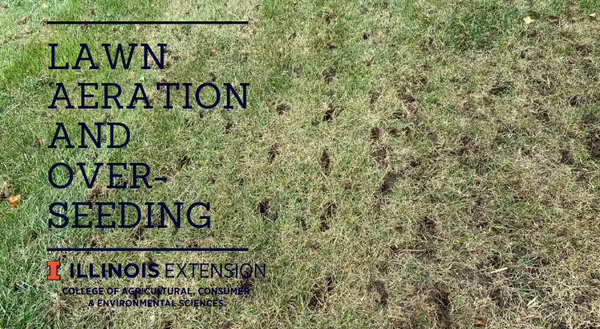
We recently bought a home at the end of May with a lawn in need of assistance. When we moved in, we quickly tackled the mole problem by trapping five moles, and one vole! Next, we moved onto the damage done by the moles; we leveled out the mole hills and seeded those areas; however, in the end, we were defeated by the summer heat and our outrageous water bill. For the last 3 months, we have had a partially dead lawn with some smaller bare spots. We have been anxiously awaiting fall in hopes of making our lawn look not so much like a train wreck.
Fall is a wonderful time to repair all the lawn mistakes/issues of the season. It is also considered the best time of year to aerate your lawn. By aerating and overseeding your lawn, it establishes a denser lawn to create competition to weeds, and it relieves compaction to improve water drainage which can make the lawn less susceptible to disease and weed growth; many weeds such as yellow nutsedge, prostrate knotweed, and spotted spurge grow in wet compacted areas where grass will not grow. It also helps established lawns by allowing water, air, and nutrients move more easily to the root zone. Holes created by an aerator allows for seed to have better contact with the soil when overseeding which is important for germination.
Core or plug aeration works best as it removes a plug of soil; whereas, spike aerators can cause more compaction pressing soil together around the holes. Core aerating machines pull up several plugs of soil about the diameter of a pencil; cores will vary in length depending on how easily the machine can penetrate the soil. The cores should remain on the soil surface and will break up overtime with other yard activities. It is also an option to topdress after aerating; this is a great option to add organic matter into the soil profile. Aerating is easiest when soil is moist from irrigation or rainfall; however, it should not be done when too wet as it can create a mess. You can aerate your lawn yourself, or you can hire a lawn company to do it. Core aerators can be rented, or you can also purchase tow behind aerators for a reasonable price.
Overseeding after aerating is a great way to thicken a lawn and fill in bare spots. It is also a great way to introduce a new grass species if your current one is not what you are wanting; however, when overseeding in the fall, the cool season grasses such as fescue, ryegrass, and bluegrass tend to do best. Suggested seeding rates for fescue and ryegrass are 3-5 lbs./ 1000 sq. ft for overseeding, and 5-10 lbs./ 1000 sq. ft for new lawns, and for bluegrass, the suggested rate is 1.5 lbs./ 1000 sq. ft for overseeding, and 3 lb./ 1000 sq. ft for new lawns. In bare spots, it is a good idea to use the new lawn rate. An essential part to getting seed established is providing the seed with enough moisture to germinate. Regular watering is essential for about two weeks; it is sometimes necessary to water at least once or twice a day. Establishment of bluegrass can take about two to four weeks to germinate which can require a longer water period.
Good Growing Tip: To determine if your lawn needs aerated, take a screwdriver and insert it into your lawn when the soil is moist (best to do this in multiple locations or where you think you might have issues); if it can’t be easily inserted, your lawn likely has compaction and would benefit from aeration.